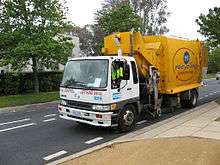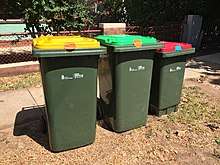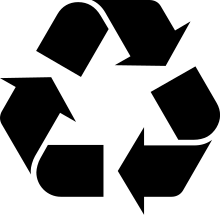Recycling in Australia
Recycling in Australia is a widespread but not comprehensive part of waste management in Australia. Various paper recycling and appliance recycling services are available.


Household recycling is encouraged through the use of recycling bins. A sampling of the contents of the recycling bin in Victoria shows around 10% of the material should not have been disposed of by bin.[2] These bins are comingled, meaning that often paper, glass and hard plastic all go into the same bin.[3]
Electronic waste collection services were mandated under The National Television and Computer Recycling Scheme. The scheme was established in 2011.[4] Australia does not have a national scheme for battery recycling.[5] Container deposit legislation has been established in several states while others are rolling out schemes. Despite some recycling and re-use of lightweight plastic bags they are being phased out.
Clean Up Australia is a national organisation dedicated to addressing environmental issues such as recycling.
In 2014-2015, 58% of all waste produced in Australia was recycled or recovered.[6] In 2016-2017, 46% of Municipal Solid Waste (MSW) was recycled.[7]
A parliamentary inquiry into the waste and recycling industry in Australia will report on 13 June 2018.[8]
On 1 January 2018, China stopped importing 24 categories of Australian recycling materials, resulting in stockpiling of recyclable materials in Australia. Waste Management Association of Australia president Garth Lamb has advocated for infrastructure projects to use recovered recycled materials rather than raw materials, such as crushed glass replacing sand in roadworks.[9] The ban imposes levels of purity of accepted materials of 0.5% which are unlikely to be met by the industry in Australia.[10]
See also
References
- "Australasian Recycling Label". Recycling Near You. Archived from the original on 31 May 2019. Retrieved 5 June 2019.
- "Victorian Statewide Garbage Bin Audits". Publications and Research. Sustainability Victoria. Retrieved 28 September 2017.
- Zhou, Naaman (3 July 2018). "Is this the end of the yellow all-in-one recycling bin?". the Guardian. Retrieved 6 July 2018.
- "National Television and Computer Recycling Scheme". Department of Environmental and Energy. Retrieved 28 September 2017.
- "Battery Recycling". Fact sheets. Clean Up Australia. Retrieved 28 September 2017.
- "National Waste Report 2016" (PDF). environment.gov.au.
- "National Waste Report 2018" (PDF). environment.gov.au.
- "Waste and recycling industry in Australia". www.aph.gov.au.
- "Chinese rubbish ban 'could see end of kerbside recycling' in Australia". ABC News. 8 February 2018. Retrieved 19 April 2018.
- Downes, Jenni. "China's recycling 'ban' throws Australia into a very messy waste crisis". The Conversation. Retrieved 1 May 2018.
External links
- https://recyclingnearyou.com.au/ - run by Planet Ark, lists places that items that aren't accepted in council recycling bins can be recycled.
- https://www.cartakebackaust.com/ - responsibly recycle cars across Australia and offer a free car collection service.
